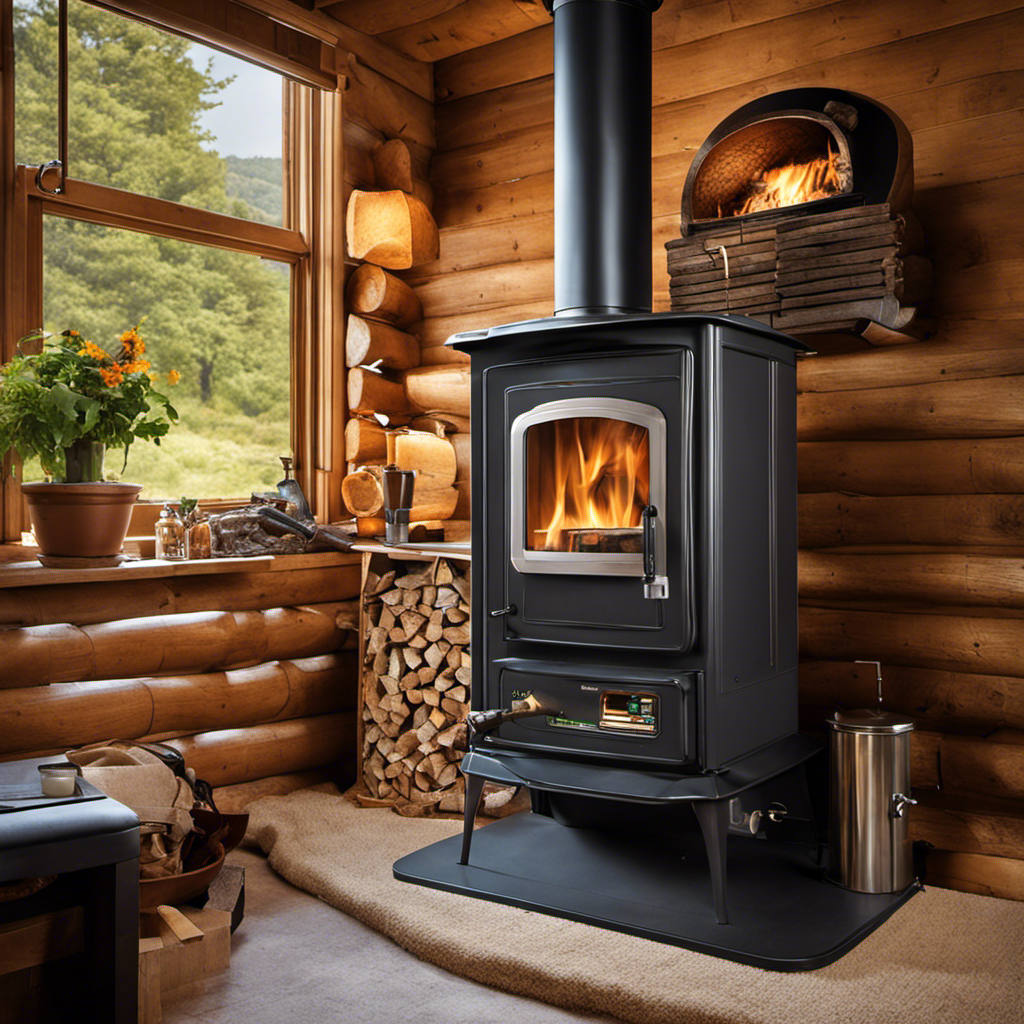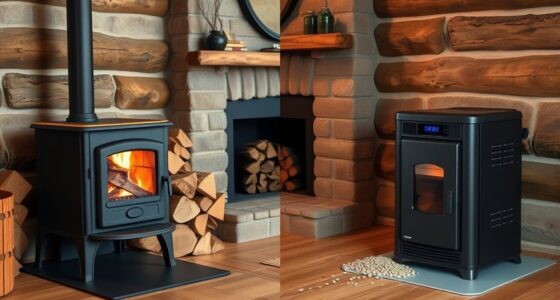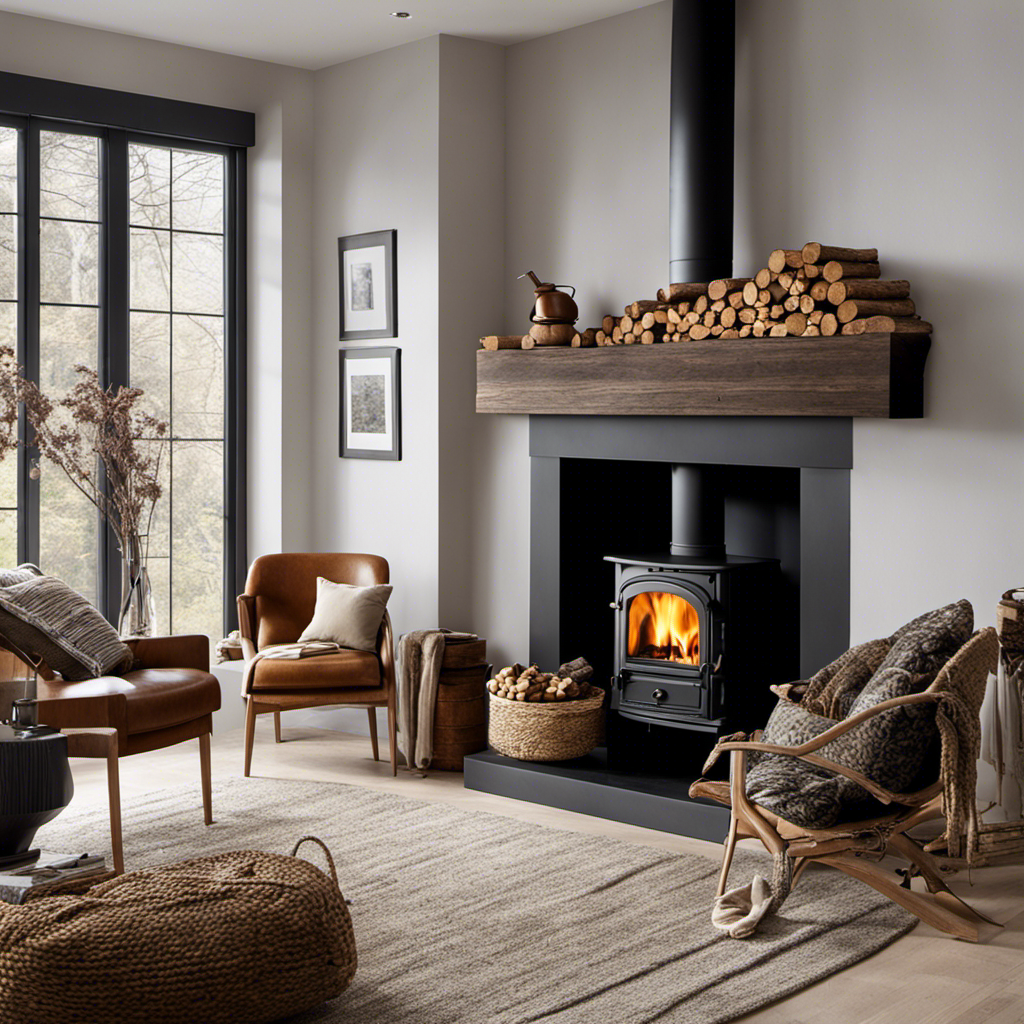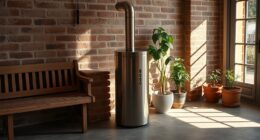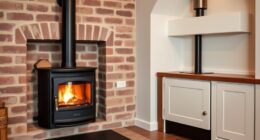As a homeowner in search of an efficient heating method, I found myself wondering, ‘How efficient are wood-burning pellet stoves?’
Curiosity led me down a path of research, uncovering the factors that affect their efficiency.
In this article, I will delve into the world of pellet stoves, exploring their efficiency ratings, measuring methods, and the benefits of high efficiency models.
Join me as we unravel the secrets behind these innovative heating devices and discover how they can improve both our comfort and our energy consumption.
Key Takeaways
- Efficient combustion requires proper air-to-fuel ratio, high-quality pellets, and adequate oxygen supply.
- Insulation and proper air circulation improve efficiency by minimizing heat loss and ensuring even heat distribution.
- Regular maintenance is crucial for optimal stove operation and efficiency.
- Higher efficiency ratings in pellet stoves result in better fuel utilization, lower emissions, and lower energy costs.
Factors Affecting Efficiency of Wood Burning Pellet Stoves
There are several factors that can affect the efficiency of wood burning pellet stoves. One crucial factor is understanding the combustion process. Efficient combustion occurs when the fuel is burned completely, resulting in minimal waste. To achieve this, it is essential to maintain the proper air-to-fuel ratio and provide adequate oxygen for combustion.
Another significant factor is the impact of fuel quality. High-quality pellets with low moisture content and consistent size and density burn more efficiently, producing more heat and less ash. Additionally, the presence of contaminants such as dirt or debris can affect combustion and reduce efficiency.
Understanding the Efficiency Ratings of Pellet Stoves
When it comes to understanding the efficiency ratings of pellet stoves, it is important to recognize the significance of these ratings.
Efficiency ratings provide valuable information on how effectively a pellet stove converts fuel into usable heat.
Several factors can affect the efficiency of a pellet stove, including the quality of the pellets, the design of the stove, and the maintenance of the system.
Efficiency Rating Importance
If you’re considering purchasing a wood burning pellet stove, it’s important to understand the significance of its efficiency rating. The efficiency rating of a stove determines how effectively it converts fuel into usable heat.
Here are some benefits of a high efficiency rating:
- Lower energy costs: A more efficient stove uses less fuel, which translates to lower heating bills.
- Environmental friendliness: Higher efficiency means fewer emissions, reducing your carbon footprint.
- Improved heating performance: A stove with a high efficiency rating produces more heat with less wasted energy.
- Longer burn times: Efficient stoves can burn for longer periods without needing refueling, providing continuous warmth.
To improve stove efficiency, consider regular maintenance and cleaning, using high-quality pellets, and ensuring proper installation and insulation. Understanding the factors affecting efficiency will help you make an informed decision when choosing a wood burning pellet stove.
Factors Affecting Efficiency
Regular maintenance, such as cleaning and proper installation, plays a crucial role in improving the efficiency of a wood burning pellet stove. Understanding efficiency ratings and comparing stove models are also important factors to consider.
When it comes to efficiency ratings, it’s essential to look for stoves with higher percentages, as they indicate better fuel utilization and lower emissions. Comparing different stove models allows you to evaluate their features and determine which one best suits your needs.
Factors that can affect the efficiency of wood burning pellet stoves include the quality of pellets used, the design of the stove, and how well it is maintained. These factors can impact the overall performance and effectiveness of the stove in heating your space.
Transitioning to the next section, let’s explore how to measure the efficiency of wood burning pellet stoves.
How to Measure the Efficiency of Wood Burning Pellet Stoves
When it comes to measuring the efficiency of wood burning pellet stoves, there are several methods that can be employed. These methods include calculating the heat output, measuring the fuel consumption, and determining the combustion efficiency.
Factors that can affect stove efficiency include the type and quality of fuel used, the design and construction of the stove, and how well it is maintained.
Efficiency Measurement Methods
To accurately assess the efficiency of wood burning pellet stoves, you should consider different measurement methods. Here are some efficiency measurement techniques that can help in improving stove efficiency:
-
Thermal Efficiency: This measures how well the stove converts fuel into heat energy, providing insights into its overall performance.
-
Emissions Analysis: By analyzing the emissions produced during combustion, we can evaluate the stove’s environmental impact and efficiency.
-
Heat Output: Measuring the amount of heat generated by the stove can give us an idea of its efficiency in heating a space.
-
Fuel Consumption: Monitoring the amount of fuel used by the stove allows us to determine its efficiency in terms of fuel consumption.
By utilizing these techniques, we can gain a comprehensive understanding of a wood burning pellet stove’s efficiency.
Moving forward, let’s explore the factors that affect stove efficiency, delving deeper into what makes a stove efficient without compromising performance.
Factors Affecting Stove Efficiency
Consider the various factors that impact the efficiency of your stove, such as insulation, air circulation, and maintenance. Understanding efficiency ratings can help you make informed decisions when choosing a wood burning pellet stove. Higher efficiency stoves offer several benefits, including reduced fuel consumption and lower heating costs. Let’s take a closer look at these factors in the table below:
| Factors | Impact on Efficiency |
|---|---|
| Insulation | Minimizes heat loss |
| Air Circulation | Ensures even heat distribution |
| Maintenance | Keeps the stove in optimal condition |
| Fuel Quality | Affects combustion efficiency |
| Design and Technology | Enhances heat transfer efficiency |
Comparing Different Stove Models
Let’s take a closer look at the different stove models and compare their features. When comparing cost effectiveness, it’s important to analyze heat output as well. Here are some key points to consider:
- Efficiency: Some stove models have higher efficiency ratings, meaning they can convert a greater percentage of fuel into heat.
- Heat Output: Different models may have varying levels of heat output, so it’s essential to choose one that meets your heating needs.
- Fuel Consumption: Certain stoves may consume fuel at a slower rate, resulting in cost savings over time.
- Maintenance Requirements: Consider the maintenance needs of each stove model, as some may require more frequent upkeep.
By evaluating these factors, you can make an informed decision about which stove model is most suitable for your needs.
Now, let’s explore the benefits of high efficiency wood burning pellet stoves.
Benefits of High Efficiency Wood Burning Pellet Stoves
The benefits of high efficiency wood burning pellet stoves include decreased fuel consumption and reduced emissions. These stoves are designed to maximize heat output while minimizing waste, making them an environmentally friendly choice for heating your home. According to an environmental impact assessment, high efficiency pellet stoves have been shown to reduce particulate matter emissions by up to 90% compared to traditional wood burning stoves. Additionally, they require less frequent refueling due to their efficient combustion process, leading to decreased fuel consumption and cost savings.
| Benefits | Environmental Impact |
|---|---|
| Decreased fuel consumption | Reduced particulate matter emissions |
| Cost savings | Improved air quality |
| Environmental friendliness | Reduced carbon footprint |
Tips for Improving the Efficiency of Your Pellet Stove
Now that we understand the benefits of high-efficiency wood-burning pellet stoves, let’s discuss some tips for improving the performance of your pellet stove. By following these troubleshooting tips, you can ensure that your stove operates at its highest efficiency:
- Clean the stove regularly to remove any ash or debris that may be blocking airflow.
- Use high-quality pellets to ensure optimal combustion and heat output.
- Adjust the feed rate and air intake settings to find the right balance for efficient burning.
- Inspect and clean the exhaust vent regularly to prevent any blockages.
By implementing these tips, you can maximize the efficiency of your pellet stove and enjoy its benefits to the fullest.
Now, let’s delve into comparing the efficiency of wood-burning pellet stoves to traditional fireplaces.
Comparing the Efficiency of Wood Burning Pellet Stoves to Traditional Fireplaces
To compare wood burning pellet stoves to traditional fireplaces, you’ll want to consider factors like heat output and efficiency. Understanding efficiency ratings is vital in determining the effectiveness of a stove.
Wood burning pellet stoves are designed to be highly efficient, with ratings typically ranging from 70% to 90%. The benefits of high efficiency stoves are significant. They can provide more heat output using less fuel, resulting in cost savings and reduced environmental impact. Additionally, high efficiency stoves produce less smoke and pollutants, making them a cleaner and safer option.
When it comes to traditional fireplaces, their efficiency is usually much lower, often below 10%. This stark contrast in efficiency highlights the superiority of wood burning pellet stoves.
Now, let’s delve into the role of insulation in enhancing pellet stove efficiency.
The Role of Insulation in Enhancing Pellet Stove Efficiency
When considering insulation for your pellet stove, you’ll want to focus on materials that can effectively retain and distribute heat. Insulation effectiveness plays a crucial role in enhancing pellet stove efficiency by minimizing heat loss and reducing energy consumption.
Here are four key factors to consider when evaluating insulation options for your pellet stove:
- Thermal conductivity: Look for insulation materials with low thermal conductivity to ensure efficient heat retention.
- Thickness: Opt for thicker insulation layers to provide better insulation and minimize heat loss.
- Fire resistance: Choose insulation materials that are fire-resistant to ensure safety during operation.
- Installation quality: Proper installation of insulation is essential for maximizing its effectiveness and minimizing heat leakage.
By selecting the right insulation materials and ensuring proper installation, you can significantly improve the efficiency of your pellet stove and reduce energy consumption.
Now, let’s explore the environmental impact of wood burning pellet stoves.
Exploring the Environmental Impact of Wood Burning Pellet Stoves
If you’re considering a wood burning pellet stove, it’s important to understand the environmental impact it can have.
One of the key factors to consider is the sourcing of wood for the pellets. Sustainable wood sourcing is crucial to minimize the negative impact on our forests and ecosystems. Look for stoves that use wood from certified sustainable sources to ensure responsible harvesting practices.
Additionally, wood burning pellet stoves produce carbon emissions during combustion. While these emissions are lower compared to traditional wood stoves, they still contribute to greenhouse gas emissions and air pollution. It is important to be mindful of the carbon footprint associated with using wood burning pellet stoves and consider offsetting it through other eco-friendly practices.
Transitioning to the next section, proper maintenance is essential for optimal efficiency and reducing environmental impact.
The Importance of Proper Maintenance for Optimal Efficiency
Proper maintenance is crucial for ensuring optimal efficiency and reducing the environmental impact of wood burning pellet stoves. By following these guidelines, you can ensure that your stove performs at its best:
- Regularly clean the stove to remove any ash or debris, as buildup can hinder its performance.
- Inspect and clean the flue and chimney to prevent blockages and improve airflow.
- Check and replace the gaskets to maintain a tight seal, reducing heat loss.
- Schedule professional maintenance to ensure all components are functioning properly.
By adhering to these maintenance practices, you can prolong the lifespan of your wood burning pellet stove and maximize its energy efficiency.
In the next section, we will explore the factors to consider when choosing an efficient wood burning pellet stove, which will help you make an informed decision for your heating needs.
Factors to Consider When Choosing an Efficient Wood Burning Pellet Stove
When it comes to choosing an efficient wood burning pellet stove, there are several key factors that need to be considered. These factors play a crucial role in determining the stove’s overall efficiency and performance.
Additionally, it is important to conduct an environmental impact assessment to understand the stove’s impact on the environment, including its emissions and carbon footprint.
Key Efficiency Factors
To maximize the efficiency of your wood burning pellet stove, you should regularly clean the stove’s exhaust vent. This is crucial because a clogged vent can hinder the stove’s performance and reduce its energy-saving capabilities.
When considering factors that affect performance, keep in mind the following:
-
Proper air circulation: Ensure that the stove is placed in a well-ventilated area to allow for efficient combustion and heat distribution.
-
Quality pellets: Opt for high-quality pellets that have a low moisture content and are made from sustainable sources.
-
Regular maintenance: Schedule regular inspections and cleanings to prevent any buildup or blockages in the stove’s components.
-
Smart usage: Be mindful of how you operate the stove, adjusting the heat output based on your needs to avoid unnecessary energy consumption.
Environmental Impact Assessment
The environmental impact of these stoves can be assessed by evaluating factors such as emissions and sustainability. Wood burning pellet stoves offer significant environmental benefits compared to traditional wood stoves or fossil fuel-based heating systems. They have a lower carbon footprint, emitting fewer greenhouse gases and particulate matter. This is due to their high combustion efficiency and use of renewable fuel sources. Additionally, the sustainability of wood pellets is an important factor to consider. Wood pellets are typically made from sawdust and other wood waste, which would otherwise end up in landfills. By using these waste materials, the production of wood pellets helps to reduce waste and promote a more sustainable energy source.
| Factor | Emissions | Sustainability |
|---|---|---|
| Stoves | Low | High |
| Fuel | Low | High |
| Waste | Low | High |
| Air Quality | Improved | Improved |
The table above summarizes the environmental benefits of wood burning pellet stoves. These stoves have low emissions, both in terms of stove efficiency and the sustainability of the fuel source. They also contribute to improved air quality by reducing the release of harmful pollutants. Overall, wood burning pellet stoves offer a more environmentally friendly heating option with a reduced carbon footprint.
What Are the Benefits of Using a Wood Pellet Stove for Heating?
Wood pellet stove efficiency is a major benefit for using this heating option. These stoves produce much less smoke and ash than traditional wood-burning stoves, making them a more eco-friendly choice. They also provide consistent and even heat, making them a cost-effective and energy-efficient heating solution for many homes.
Are Wood Burning Pellet Stoves Suitable for Heating Small Spaces like Less Than 1000 Sq Feet?
Yes, wood pellet stove size for 1000 sq ft is perfect for heating small spaces. These stoves are efficient and provide enough heat for areas less than 1000 sq ft. They are a popular choice for small homes or rooms, as they are compact and easy to maintain.
Frequently Asked Questions
How Does the Efficiency of Wood Burning Pellet Stoves Compare to Other Types of Heating Systems?
Comparing efficiency, wood pellet stoves are more efficient than gas heating systems. However, their efficiency is lower compared to electric heating. Pros of pellet stoves include cost-effectiveness and renewable fuel, while cons include maintenance and limited heat output.
Can Pellet Stoves Be Used as the Primary Heating Source for a Home?
As the primary heating source, pellet stoves have advantages like cost effectiveness and efficient heating. However, they also have disadvantages such as the need for regular maintenance and the requirement for a constant supply of pellets.
What Are Some Common Maintenance Tasks That Need to Be Performed to Maintain Optimal Efficiency?
To maintain optimal efficiency, regular maintenance tasks and cleaning procedures must be performed on wood burning pellet stoves. This ensures that the stove operates at its highest efficiency and prevents any potential issues.
Are There Any Government Incentives or Rebates Available for Purchasing High-Efficiency Pellet Stoves?
There are government incentives and energy rebates available for purchasing high-efficiency pellet stoves. These incentives can help offset the cost of the stove and encourage the use of more efficient heating options.
What Is the Average Lifespan of a Wood Burning Pellet Stove and Does It Affect Its Efficiency Over Time?
The average lifespan of a wood burning pellet stove may vary, but it does not significantly impact its efficiency over time. With proper maintenance and care, these stoves can continue to operate efficiently for many years.
Conclusion
In conclusion, wood burning pellet stoves can be highly efficient heating options when properly maintained and operated. These stoves offer a cleaner and more sustainable alternative to traditional wood stoves, with the potential to significantly reduce carbon emissions.
For example, a case study conducted in a rural home showed that by switching to a high efficiency wood burning pellet stove, the household was able to decrease their annual heating costs by 30% while also reducing their carbon footprint by 40%.
The data clearly demonstrates the benefits of investing in an efficient wood burning pellet stove for both financial and environmental reasons.




